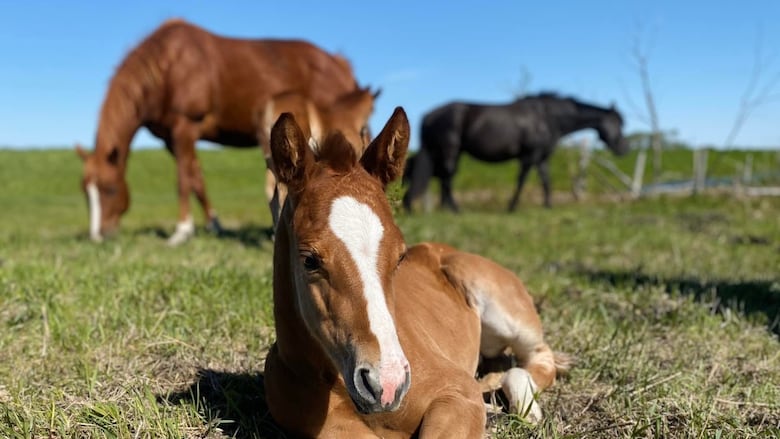Horses get asthma, too, but environmental shifts, access to hay are causing more problems, Sask. prof says
Hay for feeding can include mould and dust, which don't help asthma, Julia Montgomery says

Itchy, watery eyes, sneezing and trouble breathing are all symptoms allergy sufferers are very familiar with. Just like humans, horses also suffer from allergies.
When it gets really bad it can also lead to an asthma attack, or equine asthma.
Julia Montgomery, an associate professor in the department of large animal clinical sciences at the Western College of Veterinary Medicine at the University of Saskatchewan, specializes in equine asthma and says the basic principle behind an attack in humans and horses — lower airway inflammation — is the same.
And like humans, some animals are predisposed to asthma. Montgomery says environmental triggers can exacerbate an asthmatic episode, which is usually caused by poor air quality. But what separates humans and horses is food options. Horses rely on a diet of hay, which can contain mould or dust.

Climate change's impact on air quality, like through wildfires and drought, will affect health, Montgomery said.
"It will have a negative impact on people and horses that suffer from these chronic respiratory diseases."
Reduced hay availability is the other factor Montgomery is concerned about. Hay quality is one of the biggest obstacles horse owners face, and "when there is a shortage, sometimes out of sheer necessity, you have to accept poor quality hay," she said.
'Tough to see': owner
Kassidy Zrudlo knows first-hand the challenges of caring for an asthmatic horse. She runs Hamton Hill Equestrian farm with her husband in Rhein, Saskatchewan.
Zrudlo has been involved in the horse community for twenty years, and has been running an equestrian facility for the past three years. The number of horses she's seen presenting with asthma — also known as heaves — is increasing.
"In more recent years, more horses I've seen come through here [with asthma] and things like that, it's a lot more common than people think."
Her horse Jellybean also has asthma.
"It's really tough to see, know you feel bad for them and you want to do everything that you can."
Symptoms of equine asthma can range from mild to severe. Montgomery says in mild cases it will look like "coughing during exercise, especially at the beginning," and not performing at a normal level.
In more severe cases, Montgomery says a horse's breathing rate goes up, and "they can show nostril flaring, and even stand a little bit more stretched out, and with their neck stretched out, trying to get as much air in as possible."
One way to manage asthma is just like humans would, with an inhaler, Montgomery said. Medication is "inserted in the left nostril and administered like an inhaler," but she says this should be used when other factors in the environment, like poor air quality, can't be controlled..
Between 70 to 75 per cent of horses could have an asthma episode sometime in their life, Montgomery says.
Winter challenges
Zrudlo says managing Jellybean's asthma in the winter months is her biggest challenge. Jellybean can't go outside to eat fresh grass, and eats hay instead, which Zrudlo says irritates her airway.
"We really have to watch the quality of hay that we're feeding her and make sure that it's very, very minimal dust."
And when that isn't possible, Zrudlo resorts to feeding Jellybean alfalfa cubes soaked in water.
"It's just kind of like eating a mush. So then there is no dust involved." Zrudlo says there is a physical cost to this, however, as Jellybean can lose weight over the winter on that diet.

Last summer, Saskatchewan's air quality risk levels were listed as very high by Environment and Climate Change Canada, with warnings for people with respiratory conditions to stay indoors. For horses, that's not always possible.
"I actually noticed with a lot of my herd of horses coughing due to all the smoke that we had last year," Zrudlo said, noting this was even among the healthy horses.
Hay bale shape is also very important. Montgomery says round bales are a big factor in flaring up asthma attack: "Round beds have a tendency to spoil more easily."
Horses also approach eating square and round bales differently. They'll dig their noses right into the centre of a round bale, which is often where the mould is found, Montgomery said.
One option to manage this is using a hay steamer, which Montgomery said can dramatically reduce respirable dust in hay and kill mould, fungal spores and bacteria. Hay steaming is something Zrudlo is considering for her horses.
A diagnosis of equine asthma isn't career-ending for the animal though, and Montomgery and Zrudlo agree that with a little extra care, the horses should be able to keep going.


